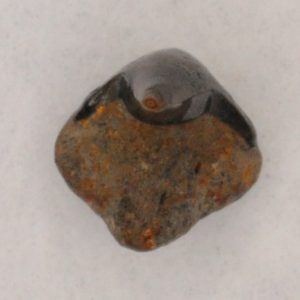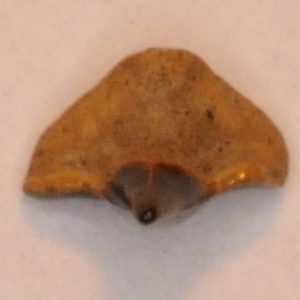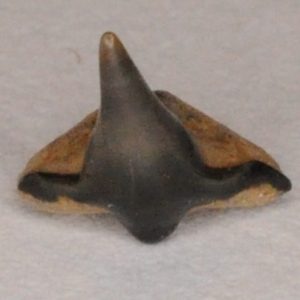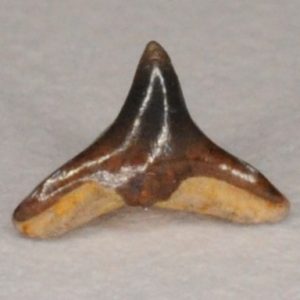NJfossils.com
"Fossils aren't a hobby, they're a lifestyle."Angel (Squatina hassei)
Age- Late Cretaceous Commonality- Less Common Size- teeth: ~ ¼ inches, vertebrae: ½ – 1 ½ inches:
Squatina was a bottom dwelling shark which hid under sand and fed on fish that happened to swim above it. Its teeth are fairly small and look similar to thumb tacks. The root is large. The crown is small and has a single projection which emerges from the labial part of the root. The tooth also has two enameled shoulders adjacent to the crown. The crown angle can change depending on tooth position. The vertebrae are rare and normally have calcified cartilage attached to the sides of the centrum. The vertebrae are similar to ray vertebrae and can be difficult to distinguish between ray verts that have cartilage attached.
Anterior Teeth
Anterior teeth are not as common as lateral teeth. They have a narrower root and have almost no curvature towards the distal side.
This anterior tooth has a different morphology than the one above. Its root is less massive in comparison to the crown and the lingual protuberance is diminished. The crown has almost no recurve.
Lateral Teeth
An angel shark’s dentition has more lateral teeth than anterior teeth. Lateral teeth are distally angled and have a wider root. They are also slightly more massive.
This lateral tooth has a different morphology than the one above. It has a thinner crown, a larger nutrient pore (visible in lingual view), a larger foramen (visible in basal view), and is more recurved.
This tooth is a juvenile lateral tooth. Juvenile tooth features are less developed. Based on my experience, juvenile angel shark teeth are not as common as the adult ones in the area.
This is a large lateral tooth. This one came from a more posterior position in the shark’s mouth. Its root is even wider than the roots of the other angel shark teeth shown; its height to width ratio is also smaller.
Angel Shark (?) Vertebrae
This vertebra is either from a Squatina hassei or some type of batoid (ray). These Squatina sp./batoid vertebrae with cartilage attached are currently unidentifiable to a specific species since angel shark and some batoid vertebrae are very similar and not much research has been done on fossil vertebrae. This type of vertebra is fairly rare. There are vertebrae that are quite similar to this type, except they don’t have cartilage attached to the centrum. There is a possibility that these vertebrae simply have their cartilage better preserved than the similar vertebrae lacking cartilage; however, this type of vertebra seems to have a centrum with a smaller anterior face than posterior face, which is unlike the centra of the “regular” vertebrae that have faces of the same size. This difference in face size is a characteristic of ancient Cretaceous angel sharks (some post-Cretaceous/modern angel sharks have faces of the same size), but there is a high chance that some species of ancient New Jersey batoids had the same feature. This vertebrae type with attached cartilage will remain unidentified for a while.
This is a juvenile Squatina sp./batoid vertebra. Its centrum and overall size is significantly smaller than the adult vertebra above.
















































